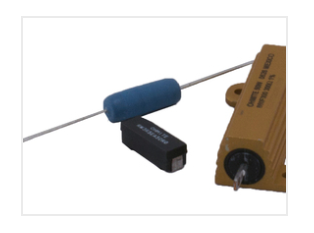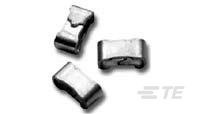In the previous article, we discussed composition and film type fixed value resistors. Continuing the discussion on fixed resistors, now let us talk about wirewound, foil and semiconductor type fixed resistors.
Wirewound Resistors
Wirewound resistors are made by winding a resistive wire around a non-conducting core. The resistive wire is usually made up of an alloy (Nichrome or Manganin), and the non-conducting core is typically ceramic or fiberglass rod. The resistive wire is wrapped around the non-conducting core in a spiral helix with a flameproof insulating cement coating over the wrap. The wirewound resistors may come either in a metallic case bolted to metal chassis or PCB mount arrangement. The wirewound resistors have the following KPIs:
Nominal Value – These resistors come in a wide range of resistance as low as 400 uΩ to 560 KΩ. Despite low values of resistance, these resistors are capable of dissipating a large amount of power (heat).
Power Rating – The wirewound resistors are actually meant for either high precision or high power applications. Their power rating typically ranges from 1 W to 300 W. There are wirewound resistors available with power rating as low as 75mW to as high as 2.5KW.
Tolerance – These resistors typically have a tolerance between 0.1% to 5%. They can have tolerance as low as 0.01%. The wirewound resistors are either high precision or high power. They have high precision only for low values of resistance. Higher is their resistance, higher are their tolerance levels.
Voltage Rating – Wirewound resistors are usually robust. They can handle high voltage and current despite low values of resistance.
Temperature Rating – These resistors are high power resistors and can tolerate temperatures up to 400°C. They usually have a positive temperature coefficient which may be as low as 20 PPM to 400 PPM. They may be enclosed in a metal case and chassis which works as a heat sink for the resistor. Even low-value high precision wirewound resistors, unlike carbon film or metal film type resistors, are not susceptible to disintegration due to excess heat.
Pulse Stability – Wirewound resistors can tolerate large amounts of current and withstand high power dissipation, so they do have good pulse stability.
Frequency Response, Noise & Stability – The Wirewound resistors have resistive wire wrapped in a spiral helix, so they have specific inductance and capacitance despite offering precise resistance. Due to reactive components, these resistors are not suitable for high-frequency applications. The wirewound resistors should not be used in circuits involving frequencies higher than 50 kHz. However, despite inductance and capacitance, these resistors have low noise levels. They are pretty stable, offering precise resistance even in extreme environmental conditions.
Size – Apart from a limited frequency range, size is another drawback of wirewound resistors. These resistors are usually bulky irrespective of the package type. The size may not be a big concern for wirewound resistors as they are meant exclusively for high power applications (typically 5 Watt to 300 Watt). The wirewound resistors for high precision applications come available in low resistance values with limited package sizes that can be generally PCB mounted.
Reliability – Wirewound resistors are robust and reliable. Due to the limited frequency range, precision dependant on the resistance value and size factor, wirewound resistors are rarely used in “common” circuits. They are usually reserved for high precision applications where the circuit has to operate within the limited frequency range or in high power applications where power dissipation must be exclusively managed.

Example of a wirewound resistor (Source: Ohmite)
Wirewound resistors have the following pros and cons:
Pros – High Precision, High Power, Robustness, Reliability, Stability, Wide operating temperature range.
Cons – Limited range of resistance, Precision dependant on resistance value, Limited frequency range (less than 50 kHz), Bulky size.
Therefore, wirewound resistors are suitable for high-precision applications that have to operate in a limited frequency range, harsh temperature, and environmental conditions, and high power applications (greater than 5 Watt). They are not good for “common” circuits having power requirement less than 5 W, high-frequency applications, and circuits meant to be size- constrained.
Foil Resistors
Foil Resistors are similar to metal film resistors except that they are constructed like high precision wirewound resistors. These resistors are made by cementing a metallic foil on a ceramic substrate. The foil is typically several micrometers thick. These are the most stable and precise resistors. Foil Resistors have the following KPIs –
Nominal Value – The main disadvantage of Foil Resistors is their limited range of resistance value. These resistors have nominal value in a range from 2mΩ up to 500 KΩ. Despite high precision and excellent stability, their lack of availability for a high value of resistances somewhat limits their use in regular circuits.
Power Rating – These resistors come available with power rating from 1/10 Watt to 10 Watt. These are typically suitable for high precision applications below 5 Watt as foil resistors are more comparable to metal film resistors than wirewound resistors. For high power applications, wirewound resistors are more suitable compared to any other type.
Tolerance – Foil resistors are known for high precision and stability. These have tolerance as low as 0.005% and as high as 5%.
Voltage Rating – These resistors have limited resistance range, as well as a limited voltage rating. Their voltage rating ranges from 20 V to 600 V.
Temperature Rating – The resistive foil in these resistors is certain micrometer thick. So, these resistors have a temperature range between -65°C to 170°C. Their temperature range is notably less than both metal film as well as wirewound resistors.
Pulse Stability – Foil resistors have good pulse stability and can withstand voltage surges provided peak voltage remains within tolerated range.
Frequency Response, Noise & Stability – Foil resistors have excellent frequency response, low noise, and remarkable stability. For stability and frequency response, there is no match to foil resistors.
Size – The design technique of foil resistors make them quite compact. The size factor serves a great advantage to foil resistors for applications involving power between 5 Watt to 10 Watt.
Reliability – Foil resistors are considered the most reliable type of resistors credits to their high precision, great stability, and excellent frequency response. However, the limited temperature range is a significant disadvantage for these resistors.

Example of foil resistors (Source: TE Connectivity)
Foil resistors have the following pros and cons:
Pros – high Precision, compact size, low to medium power rating, excellent frequency response, low noise, stability.
Cons – limited range of resistance, limited voltage rating, limited temperature rating.
Therefore, foil resistors are good for high precision applications with limited resistance, temperature and voltage rating, medium power applications (5 W to 10 W) where circuit must be compact; and high-frequency applications. They are not good for “common” circuits where regular tolerance levels are acceptable, high power applications, and regular circuits that may expose to extreme electrical or environmental conditions.
Semiconductor resistors
Semiconductor resistors are made by depositing a thin film of resistive material on a small ceramic substrate. The substrate with the resistive coating is cut precisely by laser to produce the desired resistance. These resistors are also called chip resistors, IC resistors, and SMT resistors. A semiconductor resistor package may have a single resistor or an array of resistors. These resistors are meant for low power, high frequency, precision surface mount applications with requirement of small footprints. They are actually thin film or thick film SMD resistors and are available in a wide range of resistance with typical tolerance from 0.1% to 5%. Their power rating typically ranges from 12.5 mW to 0.25 W. There are semiconductor resistors available with a power rating up to 150 W for critical applications.
Special Resistors
There are some special type of resistors available for particular applications. Some of them are described below:
Fuse resistors – Fuse resistors can be carbon composition, metal film, metal oxide film, wirewound or thin-film type. These act as both a resistor, as well as a fuse. They have a rated voltage rating at which they melt down. Fuse resistors come in two types – fast burn and slow burn. These resistors have a flame retardant coating to avoid any fire breakout in case of a voltage surge and are used in overload protection and constant voltage applications.
Zero Ohm resistors – a Zero Ohm Resistor is a piece of wire enclosed in a diode-like package. These resistors look like diodes and have a black strip in the center (unlike diodes which have a black strip at the cathode end). They are used as crossovers, permanent jumpers, and program jumpers in commercial PCBs, as well as a jumper-to-jumper capacitance with high-speed data lines. In comparison to bare wire, these resistors are easy to handle in a mechanized PCB assembling machine.
In the next article, we will check out the Resistor Selection Cheat Sheet. Before that, here are two more Do-It-Yourself activities.
Activity 3
Download some random datasheets of metal film resistors, wirewound resistors, and foil resistors. Compare their tolerance and frequency response. Try to draw a conclusion on their suitability for different electronic applications.
Activity 4
Look for different types of resistors on different online market places (Like Mouser, Element14, Digi-Key, etc.) and explore different mounting styles and various packaging of resistors.
Filed Under: Tutorials



Questions related to this article?
👉Ask and discuss on Electro-Tech-Online.com and EDAboard.com forums.
Tell Us What You Think!!
You must be logged in to post a comment.